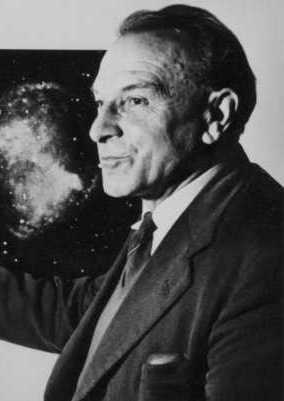Difference between revisions of "Charles E R Bruce"
(Imported from text file) |
(Imported from text file) |
||
| Line 15: | Line 15: | ||
<dl><dd>"Similarity between quantities he had calculated from [http://en.wikipedia.org/wiki/First_principles first principles] in his work on lightning, and values deduced from astrophysical observations, led Charles Bruce to the conclusion that most [http://en.wikipedia.org/wiki/Astrophysics astrophysical] phenomena could be interpreted as the results of [http://en.wikipedia.org/wiki/Electrostatic_discharge electrical discharges] on the cosmic scale. The idea totally captured his imagination, and he developed it with great vigour in a series of about fifty publications, being greatly encouraged in this work by two highly respected astrophysicists, [http://en.wikipedia.org/wiki/Sydney_Chapman_%28astronomer%29 [Sydney] Chapman] at Oxford and [http://en.wikipedia.org/wiki/F.J.M._Stratton [F.J.M.] Stratton] at Cambridge."<sup id="cite_ref-0" class="reference">[http://en.wikipedia.org/wiki/Charles_Bruce_%28physicist%29#cite_note-0 <span>[</span>1<span>]</span>]</sup></dd></dl> In 1952, he submitted his papers on electrical discharges to Edinburgh University and was subsequently awarded a [http://en.wikipedia.org/wiki/Doctorate_of_Science Doctorate of Science]. He was also awarded the Silver Pen from the [http://en.wikipedia.org/wiki/Franklin_Institute Franklin Institute] for his writing skills. - [http://en.wikipedia.org/wiki/Charles_Bruce_%28physicist%29 http://en.wikipedia.org/wiki/Charles_Bruce_%28physicist%29] | <dl><dd>"Similarity between quantities he had calculated from [http://en.wikipedia.org/wiki/First_principles first principles] in his work on lightning, and values deduced from astrophysical observations, led Charles Bruce to the conclusion that most [http://en.wikipedia.org/wiki/Astrophysics astrophysical] phenomena could be interpreted as the results of [http://en.wikipedia.org/wiki/Electrostatic_discharge electrical discharges] on the cosmic scale. The idea totally captured his imagination, and he developed it with great vigour in a series of about fifty publications, being greatly encouraged in this work by two highly respected astrophysicists, [http://en.wikipedia.org/wiki/Sydney_Chapman_%28astronomer%29 [Sydney] Chapman] at Oxford and [http://en.wikipedia.org/wiki/F.J.M._Stratton [F.J.M.] Stratton] at Cambridge."<sup id="cite_ref-0" class="reference">[http://en.wikipedia.org/wiki/Charles_Bruce_%28physicist%29#cite_note-0 <span>[</span>1<span>]</span>]</sup></dd></dl> In 1952, he submitted his papers on electrical discharges to Edinburgh University and was subsequently awarded a [http://en.wikipedia.org/wiki/Doctorate_of_Science Doctorate of Science]. He was also awarded the Silver Pen from the [http://en.wikipedia.org/wiki/Franklin_Institute Franklin Institute] for his writing skills. - [http://en.wikipedia.org/wiki/Charles_Bruce_%28physicist%29 http://en.wikipedia.org/wiki/Charles_Bruce_%28physicist%29] | ||
| − | [[Category:Scientist]] | + | [[Category:Scientist|Bruce Charles]] |
[[Category:Electric Universe]] | [[Category:Electric Universe]] | ||
Revision as of 12:33, 30 December 2016
Charles E. R. Bruce | |
|---|---|
 | |
| Born | December 0, 1902 Template:Error Template:Error |
| Died | December 30, 1979 |
| Residence | Edinburgh, SCOTLAND, United Kingdom |
| Known for | Electric Discharge, Electric Universe |
Charles Edward Rhodes Bruce (C.E.R. Bruce), MA., DSc., FIEE., FInstP., (1902 near Glasgow ? 30 Dec 1979) was a Scottish astrophysicist and writer. He was educated at Edinburgh University where he finished with First Class Honours in Mathematics and Natural Philosophy.
1924 he joined the Electrical Research Association (now ERA Technology Ltd) in Leatherhead, England, where he began analysing the operation of oil circuit-breakers. An interest in electrical arcing developed into a study of lightning discharges, where
- "Similarity between quantities he had calculated from first principles in his work on lightning, and values deduced from astrophysical observations, led Charles Bruce to the conclusion that most astrophysical phenomena could be interpreted as the results of electrical discharges on the cosmic scale. The idea totally captured his imagination, and he developed it with great vigour in a series of about fifty publications, being greatly encouraged in this work by two highly respected astrophysicists, [Sydney Chapman] at Oxford and [F.J.M. Stratton] at Cambridge."[1]
In 1952, he submitted his papers on electrical discharges to Edinburgh University and was subsequently awarded a Doctorate of Science. He was also awarded the Silver Pen from the Franklin Institute for his writing skills. - http://en.wikipedia.org/wiki/Charles_Bruce_%28physicist%29